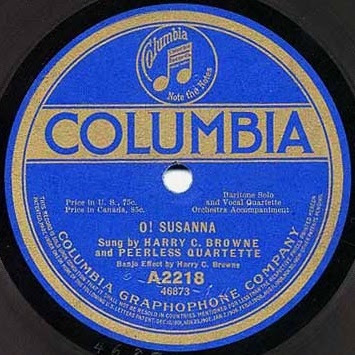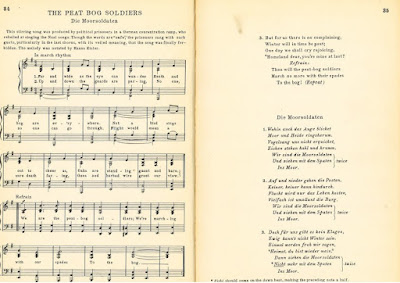http://www.folklorist.org/song/Oh!_Susanna
In 1846, Stephen Foster moved to Cincinnati, Ohio, and became a bookkeeper with his brother's steamship company. While in Cincinnati, Foster wrote "Oh! Susanna", possibly for his men's social club. The song was first performed by a local quintet at a concert in Andrews' Eagle Ice Cream Saloon in Pittsburgh, Pennsylvania on September 11, 1847.
It was first published by W. C. Peters & Co. in Cincinnati in 1848., who bought the song for $100, but before they could publish it, it was pirated by a New York publisher (C. Holt Jr.) who printed it with the name of Edwin P. Christy as author. Christy’s Minstrels were rapidly becoming the most popular group in the Bowery theater district of Manhattan, and were to be the chief performers of Foster’s minstrel songs in the 1850s.
Sung by G.N. Christy of the Christy Minstrels in 1848:
068.045.001.webimage.JPEG (565×768)
068.045 - Music of the Original Christy Minstrels, The Oldest Established Band in the United States. Oh! Susanna. | Levy Music Collection
Image 1 of Oh! Susanna | Library of Congress
Other minstrel troupes performed the work, and, as was common at the time, many registered the song for copyright under their own names. As a result, it was copyrighted and published at least 21 times from February 25, 1848, through February 14, 1851.
Sheetmusic 1848 registered by J Turner !!?
Oh! Susanna / [sheet music]:Print Material Page Turner: Performing Arts Encyclopedia, Library of Congress
Sheetmusic 1848 registered by Wells !!?
File:Oh! Susanna 1.jpg - Wikipedia
Sheetmusic 1848 registered by Edward L. White !!?
Oh Susanna! | Library of Congress
Glenn Weiser suggests the song was influenced by an existing work, "Rose of Alabama" (1846), with which it shares some similarities in lyrical theme and musical structure.
SEE HERE: Oh! Susanna by Stephen Foster - Likely Origins
020.148 - The Rose of Alabama (Words Used by Permission of Turner & Fisher). | Levy Music Collection
Listen here:
But back to Susanna: here's the first recording I could find:
(o) Harry C. Browne and Peerless Quartette (1917) (as "O! Susanna")
Recorded in New York on October 6, 1916
Released on Columbia A 2218
Listen here:
Or here:
(c) The Great White Way Orchestra (1923) (as "Oh Susanna - medley")
under the direction of Hugo Frey
Billy Murray (tenor vocal)
Albert Campbell (tenor vocal)
John H. Meyer (bass vocal)
Recorded June 22, 1923
Released on Victor 19125
The Great White Way Orchestra / The Troubadours – Oh Susanna / Southern Melodies (1923, Shellac) - Discogs
Oh Susanna | Library of Congress
(c) Criterion Quartet (1924) (as "Oh! Susanna")
Baritone vocal George W. Reardon
Bass vocal Donald Chalmers
Tenor vocal John Young , Horatio Rench
Recorded October 10, 1923
Released on Edison 51295
Criterion Quartet* - Oh! Susanna / Lindy Lady (1924, Edison Disc) | Discogs
Listen here:
(c) Riley Puckett (1924) (as "Oh! Susanna")
Recorded September 11, 1924
Released on Columbia 15014-D.
Riley Puckett - Liza Jane / O! Susanna (Shellac) | Discogs
Listen here:
(c) Chubby Parker (1927) (as "Oh Suzzana")
vocal and whistling; acc. own tbj.
Recorded April 2, 1927 in Chicago, IL
Recorded April 2, 1927 in Chicago, IL
Released on Gennet 6097
Chubby Parker - Oh Suzzana / I'm A Stern Old Bachelor (1927, Shellac) | Discogs
Also released on Champion 15278, Silvertone 5013, 25013, Supertone 9191, Herwin 75548
Listen here:
(c) Dalhart-Robison-Hood (1927) (as "Oh Susanna")
Dalhart, Robison & Hood, vocal trio;
Vernon Dalhart, harmonica and jew's harp; unknown, banjo;
Chubby Parker - Oh Suzzana / I'm A Stern Old Bachelor (1927, Shellac) | Discogs
Also released on Champion 15278, Silvertone 5013, 25013, Supertone 9191, Herwin 75548
Listen here:
(c) Dalhart-Robison-Hood (1927) (as "Oh Susanna")
Dalhart, Robison & Hood, vocal trio;
Vernon Dalhart, harmonica and jew's harp; unknown, banjo;
Carson Robison, guitar; Adelyne Hood, fiddle;
Recorded October 27, 1927 in New York
Released on Banner 6137, Domino 4068, Jewel 5159, Oriole 1083, Regal 8450, Challenge 559, Conqueror 7063, Paramount 3075, Broadway 8066, Apex 8688, Lucky Strike 24152, Microphone 22230, Ruby 71034, Sterling 281034
Dalhart, Robison and Hood - Oh Susanna (1927, Shellac) | Discogs
Listen here:
(c) Vernon Dalhart–Carson Robison–Adelyne Hood (1927)
Vernon Dalhart–Carson Robison–Adelyne Hood, vocal trio;
acc. Adelyne Hood, f; Vernon Dalhart, h/jh; William Carlino, bj; Carson Robison, g;
Recorded November 15, 1927 in New York
Recorded October 27, 1927 in New York
Released on Banner 6137, Domino 4068, Jewel 5159, Oriole 1083, Regal 8450, Challenge 559, Conqueror 7063, Paramount 3075, Broadway 8066, Apex 8688, Lucky Strike 24152, Microphone 22230, Ruby 71034, Sterling 281034
Dalhart, Robison and Hood - Oh Susanna (1927, Shellac) | Discogs
Listen here:
(c) Vernon Dalhart–Carson Robison–Adelyne Hood (1927)
Vernon Dalhart–Carson Robison–Adelyne Hood, vocal trio;
acc. Adelyne Hood, f; Vernon Dalhart, h/jh; William Carlino, bj; Carson Robison, g;
Recorded November 15, 1927 in New York
Released on Victor 21169
Vernon Dalhart - Carson Robison - Adelyne Hood / Vernon Dalhart - Carson Robison - Oh! Susanna / When The Sun Goes Down (1928, Shellac) | Discogs
http://victor.library.ucsb.edu/index.php/object/detail/18681/Victor_21169
Listen here:
(c) Vernon Dalhart (1927)
Vernon Dalhart, v;
acc. Adelyne Hood, f; Vernon Dalhart, h/jh/ poss. William Carlino, bj; Carson Robison, guitar.
Recorded December 20, 1927 in New York
Vernon Dalhart - Carson Robison - Adelyne Hood / Vernon Dalhart - Carson Robison - Oh! Susanna / When The Sun Goes Down (1928, Shellac) | Discogs
http://victor.library.ucsb.edu/index.php/object/detail/18681/Victor_21169
Listen here:
(c) Vernon Dalhart (1927)
Vernon Dalhart, v;
acc. Adelyne Hood, f; Vernon Dalhart, h/jh/ poss. William Carlino, bj; Carson Robison, guitar.
Recorded December 20, 1927 in New York
Released on Cameo 8116, Lincoln 2770 and Romeo 539
Listen here:
(c) Dalhart–Robison–Hood, v trio;
acc. Adelyne Hood, f; Vernon Dalhart, h; poss. William Carlino, bj; Carson Robison, g.
Recorded December 20, 1927 in New York
Listen here:
(c) Dalhart–Robison–Hood, v trio;
acc. Adelyne Hood, f; Vernon Dalhart, h; poss. William Carlino, bj; Carson Robison, g.
Recorded December 20, 1927 in New York
Released on Pathe 32326 and on Perfect 12405
And in the UK on Pathe Perfect P 420
78 RPM - Dalhart, Robison And Hood - Oh Susanna / Shine On Harvest Moon - Pathé Perfect - UK - P420
Listen here:
(c) Vaughn De Leath (1929) (as "Oh! Susanna")
Recorded September 6, 1928
Released on Edison 11037
Also released on Edison 52651
Listen here:
And in the UK on Pathe Perfect P 420
78 RPM - Dalhart, Robison And Hood - Oh Susanna / Shine On Harvest Moon - Pathé Perfect - UK - P420
Listen here:
(c) Vaughn De Leath (1929) (as "Oh! Susanna")
Recorded September 6, 1928
Released on Edison 11037
Also released on Edison 52651
Listen here:
(c) Philadelphia Orchestra (1929)
Director Leopold Stokowsky
Recorded May 1, 1929
http://victor.library.ucsb.edu/index.php/matrix/detail/800021810/CVE-47969-Oh_Susanna
Listen here:
(c) Don Charles presents The Singing Dogs directed by Carl Weisman. (1955)
Here are The Singing Dogs "barking" Oh! Susanna.
The "A" side of RCA-Victor record number 20-6344 from 1955.
http://www.45cat.com/record/476344
(c) Pete Seeger (1958) (as "Oh Susanna")
On the album "American Favorite Ballads Vol. 2"
https://www.folkways.si.edu/pete-seeger/american-favorite-ballads-vol-2/american-folk/music/album/smithsonian
In 1963 Tim Rose wrote a new arrangement for "Oh Susanna".
(c) Big Three (1963) (as "The Banjo Song")
45cat - The Big Three [USA] - The Banjo Song / Winkin' Blinkin' And Nod - FM - USA - FM 3003
The Big Three – The Banjo Song (1963, Vinyl) - Discogs
Listen here:
This same arrangement was cleverly used in 1969 by Robbie van Leeuwen to "write" his blockbuster "Venus".
(c) Shocking Blue (1969) (as "Venus")
(c) Shocking Blue (1969) (as "Venus")
Listen here:
(c) Byrds (1965) (as "Oh! Susanna")
A humorous recording of "Oh! Susanna" was the last track on the second album by The Byrds, Turn! Turn! Turn!, in 1965
(c) James Taylor (1970)
James Taylor also included a version of the song on his second album, Sweet Baby James, in 1970.
(c) Taj Mahal (1971)
On the album "Happy Just to Be Like I Am"
http://en.wikipedia.org/wiki/Happy_Just_to_Be_Like_I_Am
Listen here:
(c) Michelle Shocked & Pete Anderson (2004)
On the album "Beautiful Dreamer: The Songs Of Stephen Foster"
Beautiful Dreamer - The Songs Of Stephen Foster (2004, CD) - Discogs
Listen here: Oh Susannah from Beautiful Dreamer,
(c) Carly Simon (2007)
On the album "Into White".
Into White (album) - Wikipedia
Listen here:
(c) Neil Young and Crazy Horse (2012)
Neil Young and Crazy Horse used Tim Rose's arrangement of "Oh Susanna"
(c) Byrds (1965) (as "Oh! Susanna")
A humorous recording of "Oh! Susanna" was the last track on the second album by The Byrds, Turn! Turn! Turn!, in 1965
(c) James Taylor (1970)
James Taylor also included a version of the song on his second album, Sweet Baby James, in 1970.
(c) Taj Mahal (1971)
On the album "Happy Just to Be Like I Am"
http://en.wikipedia.org/wiki/Happy_Just_to_Be_Like_I_Am
Listen here:
(c) Michelle Shocked & Pete Anderson (2004)
On the album "Beautiful Dreamer: The Songs Of Stephen Foster"
Beautiful Dreamer - The Songs Of Stephen Foster (2004, CD) - Discogs
Listen here: Oh Susannah from Beautiful Dreamer,
(c) Carly Simon (2007)
On the album "Into White".
Into White (album) - Wikipedia
Listen here:
(c) Neil Young and Crazy Horse (2012)
Neil Young and Crazy Horse used Tim Rose's arrangement of "Oh Susanna"
(see "Banjo Song" by the Big Three 1963)
























